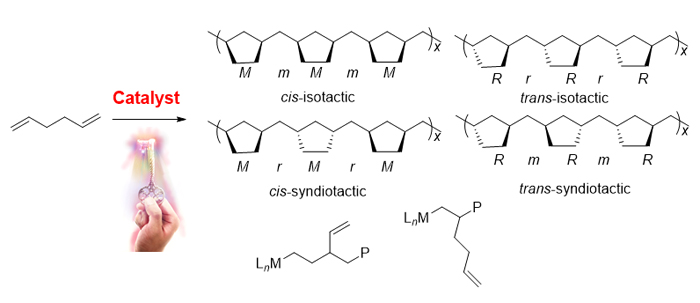摘要/Abstract

在聚烯烃行业蓬勃发展的几十年中, 如何合成具有独特结构和功能的聚烯烃一直是高分子化学家不断追求的目标. 时至今日, 科学家们已经可以通过调控单体结构、催化剂中心金属、配体结构以及聚合条件等来合成丰富多彩的聚烯烃. 在这品类繁多的聚烯烃中, 主链上含有脂肪环的聚烯烃因具有良好的热稳定性和透明度受到了广泛的关注. α,ω-双烯烃的配位聚合是获得主链含脂肪环的聚合物的一种高效手段, 这种方法具有单体易得且易修饰、聚合物微观结构可以被催化剂高效调控等优点. 根据第一次插入反应后的中间体发生的不同双键的插入反应可得到交联、含悬挂双键或含脂肪环的聚合物. 根据所得环化聚合物的环内两根支链的相对朝向将其分为顺反立构体; 再通过环与环之间的相对构型分为等规或间规立构体; 根据催化剂与单体发生第一次插入反应的 1,2-插入或 2,1-插入方式可以得到结构单元为单亚甲基环或二亚甲基环的聚合物; 根据催化剂的绝对构型不同可以得到旋光度大小一致、方向相反的手性聚合物. 上述这些聚合物的微观结构对于其聚集状态、热力学以及机械力学性能等可能会有明显的影响, 而这些均可以通过改变催化剂的中心金属和配体结构来进行精细的调控. 这篇综述着眼于α,ω-双烯烃的聚合物的精细结构, 着重介绍了如何通过变换催化剂结构来调控聚合物的结构, 并对该领域未来可能的发展方向进行了预测, 从而推动该类聚合物在构效关系、实际应用等方面的长足发展.
关键词: α,ω-双烯烃, 配位聚合, 催化剂, 微观结构, 环化聚合物
In the past decades, the polyolefin industry has been booming, and the synthesis of polyolefin with unique structure and property has been the constant pursuit of polymer chemists. Until now, scientists have been able to synthesize various polyolefins by regulating monomer structure, catalyst central metal, ligand structure and polymerization conditions. Among the various polyolefins, those with aliphatic rings in the main chain have been widely concerned because of their excellent thermal stability and transparency. The coordination polymerization of α,ω-diolefin is a very efficient approach to obtain polymers containing aliphatic rings in backbone. This method has some advantages, such as easy availability and modification of monomers, and the effective regulation of polymer microstructure by catalysts. Polymers with pendant double bonds or aliphatic rings or crosslinked gel can be obtained according to the different double bond that inserts into the intermediate generating after the first insertion reaction. According to the relative orientation of two branched chains in the ring, the polymers are divided into cis and trans isomers. By the relative configuration of the rings, there are isotactic and syndiotactic structures. Due to the 1,2-insertion or 2,1-insertion of the first insertion reaction between the catalyst and the monomer, the resultant polymers contain ring units with monomethylene or dimethylene. Under the catalyzation of complexes with different absolute configurations, chiral polymers with the same optical rotation and opposite direction can be obtained. The microstructure of these polymers should have a significant influence on their aggregation state, thermodynamics and mechanical properties, which can be finely regulated by changing the central metal and ligand structure of the catalyst. This review focuses on the microstructure of polymers of α,ω-diolefins, and emphatically introduces how to regulate the polymer structure by varying the catalyst structure. Besides, the possible development direction of this field is predicted, so as to promote the rapid development of structure-performance relationship and practical application of these polymers.
Key words: α,ω-diolefin, coordination polymerization, catalyst, microstructure, cyclopolymer
PDF全文下载地址:
点我下载PDF
